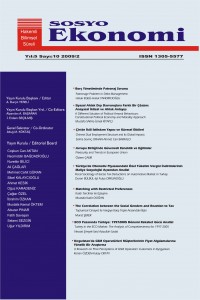Öz
This paper examines the effects of the introduction of restrictions on the statement of preferences in a two–sided matching model with incomplete information. The model is similar to the process used for college admissions in Turkey. Colleges have unanimous preferences – students with higher ranking in the national examinations are always preferred. We show that the introduction of the restrictions on statement of students' preferences can result in unstable matching between colleges and students.
Anahtar Kelimeler
Kaynakça
- Balinski, M. and T. Sonmez (1999), “A Tale of Two Mechanisms: Student Placement”, Journal of Economic Theory, 84: 73–94.
- Gale, D. and L. Shapley (1962), “College Admissions and the Stability of Marriage,” American Mathematical Monthly, 69: 9–15.
- Roth, A. E. and M. Sotomayar (1990), Two–Sided Matching: A Study in Game–Theoretic Modeling and Analysis, Cambridge, U.K.: Cambridge University Press.
- Roth, A.E. and M. Sotomayor (1992), “Two Sided Matching,” in Handbook of Game Theory with Economic Applications, (eds.) Aumann R. and S. Hart, North Holland: Elsevier, 485–541.
Öz
This paper examines the effects of the introduction of restrictions on the statement of preferences in a two–sided matching model with incomplete information. The model is similar to the process used for college admissions in Turkey. Colleges have unanimous preferences – students with higher ranking in the national examinations are always preferred. We show that the introduction of the restrictions on statement of students' preferences can result in unstable matching between colleges and students.
Anahtar Kelimeler
Kaynakça
- Balinski, M. and T. Sonmez (1999), “A Tale of Two Mechanisms: Student Placement”, Journal of Economic Theory, 84: 73–94.
- Gale, D. and L. Shapley (1962), “College Admissions and the Stability of Marriage,” American Mathematical Monthly, 69: 9–15.
- Roth, A. E. and M. Sotomayar (1990), Two–Sided Matching: A Study in Game–Theoretic Modeling and Analysis, Cambridge, U.K.: Cambridge University Press.
- Roth, A.E. and M. Sotomayor (1992), “Two Sided Matching,” in Handbook of Game Theory with Economic Applications, (eds.) Aumann R. and S. Hart, North Holland: Elsevier, 485–541.
Ayrıntılar
| Birincil Dil | İngilizce |
|---|---|
| Bölüm | Makaleler |
| Yazarlar | |
| Yayımlanma Tarihi | 1 Aralık 2009 |
| Gönderilme Tarihi | 12 Aralık 2014 |
| Yayımlandığı Sayı | Yıl 2009 Cilt: 10 Sayı: 10 |


